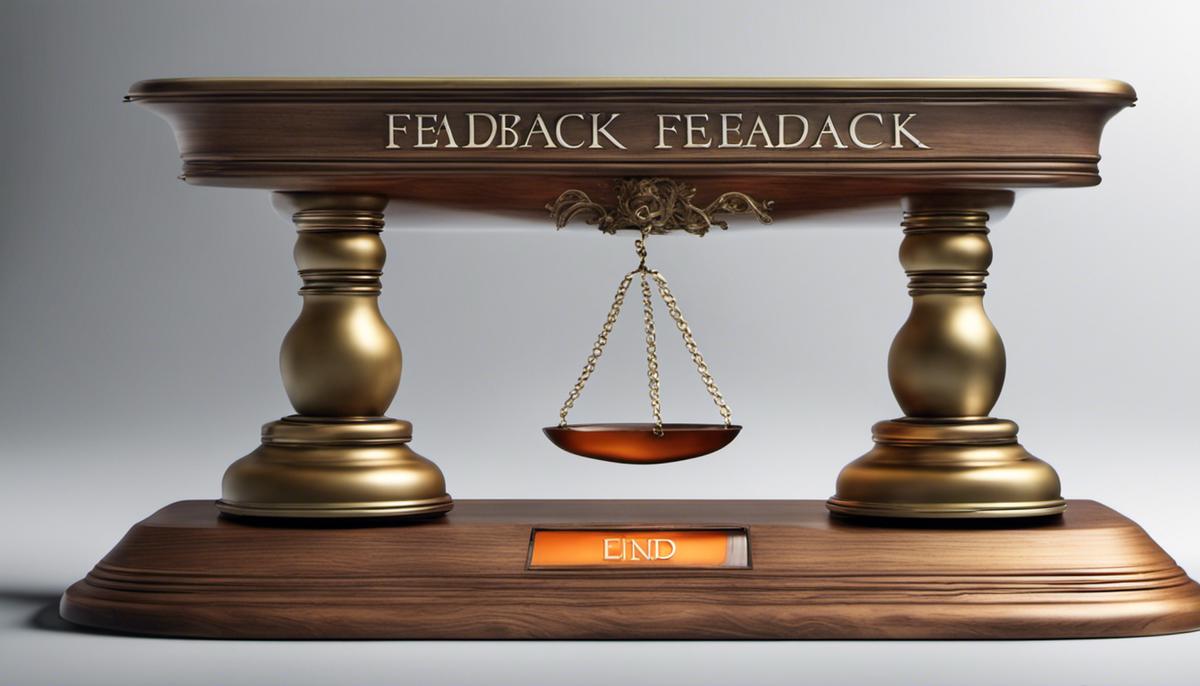Across the spectrum of human communication and interaction, feedback plays a pivotal role in shaping behaviors, influencing performance, and setting the course for growth and improvement. Ranging from personal relationships to professional environments, the words of critique or praise we share can leave a lasting impact. Understanding the concepts of positive and negative feedback, their psychological implications, and application is essential for effective communication. This article presents a comprehensive exploration into these two types of feedback, featuring their uses, impacts, and ways to utilize them effectively while citing practical examples from various scenarios.
Definition and Types of Feedback
Defining Feedback
Feedback is a response given to a person or group regarding a particular behavior or action. It acts as a mechanism to guide or correct an individual’s actions. Feedback can either be positive or negative and often plays a significant role in communication dynamics, education, and organizational settings.
Negative Feedback
Negative feedback, contrary to its name, is not always a bad thing. It involves telling someone about their mistakes and what they have done wrong. Constructive negative feedback is designed to guide and correct erroneous behavior. It can serve as a wake-up call, inducing changes that might be necessary for individual or organizational growth. However, it should be delivered with care to avoid discouraging or offending the recipient. For example, a manager might provide negative feedback to an employee who regularly comes late to work, suggesting they need to improve their punctuality.
Negative feedback also plays a crucial role in many biological and technological systems. For instance, in homeostasis – the body’s internal equilibrium – negative feedback helps maintain stable internal conditions. If a person’s body temperature rises, sweat glands are activated to cool the body, thus restoring the optimal temperature.
Positive Feedback
Positive feedback, on the other hand, recognizes specific behaviors or actions by complementing them or applauding their appropriateness. It serves to encourage and strengthen the recurrence of those positive behaviors. Positive feedback boosts morale, improves self-confidence and often leads to increased productivity. For instance, a teacher applauding a student for getting good grades would serve as positive feedback, encouraging the student to keep up the excellent work.
In biological and system processes, positive feedback amplifies changes rather than minimizing them. This mechanism accelerates processes to a specific endpoint. One well-known biological example is the amplification of labor contractions during childbirth.
Exploring the Importance of Feedback in Effective Communication
Feedback is an integral component of communication, playing a pivotal role in clearing up misunderstandings, affirming mutually shared understandings, and fostering open dialogue. Key players in this communicative process are both positive and negative feedback, essential for nurturing growth and learning in both personal and professional environments. Nevertheless, equally crucial is achieving a fine balance between the two. Overemphasis on negative feedback can stir feelings of discouragement and indignation, while relying too heavily on positive feedback might create a false narrative, potentially hampering necessary growth and maturation.
Particularly within an organizational context, feedback acts as a catalyst in fine-tuning performance, developing a growth mindset, and synchronizing individual contributions with broader organizational objectives. Effective deployment of feedback mechanisms can usher in remarkable improvements in team dynamics, employee involvement, and overall productivity levels.

Impact of Positive and Negative Feedback
Deciphering the Concepts of Positive and Negative Feedback
To bolster future performance, feedback provides invaluable insights into previous accomplishments and can broadly be classified as either positive or negative. Positive feedback, composed of praise, support, and encouragement, promotes the repetition of desirable behaviors, actions, or outcomes. On the other hand, negative feedback manifests through constructive criticism, suggestions, and other forms of information signaling possible improvement areas.
Psychological Impact of Positive Feedback
Research shows that positive feedback can fuel performance, motivation, and self-esteem. Positive reinforcement has been shown to be powerful in various environments – from schools to workplaces, where individuals feel encouraged and valued when they receive positive feedback. When an individual’s efforts are recognized and applauded, they likely experience increased motivation, leading to an enhancement in performance.
Positive feedback functions as a boost to self-esteem by accepting and validating an individual’s effort or performance, leading to feelings of worthiness, capability, and assurance. This psychological reaction can promote further valuable work or efforts and foster a complex of positive self-regard.
Implications of Negative Feedback
On the other hand, negative feedback, despite being instrumental for improvement and growth, can pose certain psychological implications. Negative feedback can spotlight specific errors, guiding individuals towards solutions and growth. However, if given improperly, it can lead to feelings of inadequacy, ineptness, or failure.
Repeated negative feedback could give rise to a lowered self-esteem and demotivation, impacting an individual’s performance and effectiveness negatively. Research shows that individuals receiving consistent negative feedback tend to display heightened stress levels, lowered satisfaction, and reduced productivity.
Feedback as a Tool for Progress or Regression
Feedback plays a critical role in shaping human behavior. When presented effectively, both positive and negative feedback can fuel growth, performance and self-improvement. Positive feedback can foster motivation, lift self-esteem and set a pathway for continuous achievement.
Negative feedback, when delivered constructively, can facilitate learning and improve performance by identifying areas of weaknesses that require improvement. However, ill-delivered negative feedback could harm self-esteem, stifle motivation, and deter personal or professional progress.
Balancing Positive and Negative Feedback
A balance of both positive and negative feedback is essential to fostering growth and positive performance. Studies indicate that a proportionate blend of both types of feedback could optimize performance, driving motivation, and maintaining a healthy self-esteem. Constructive criticism is essential for identifying areas of improvement, while positive feedback is needed to motivate, validate, and reinforce achievements.
The Essence of Feedback Delivery
The impressions left by feedback are deeply intertwined with the method of its delivery. A recommended strategy is to utilize a ‘feedback sandwich’ – a positive comment, followed by constructive criticism, and then another positive comment. This careful handling helps maintain a person’s self-esteem while providing necessary feedback for growth.
For feedback to truly leave a mark, whether positive or negative, it should be precise, comprehensible, and based on actions rather than personal characteristics. In this manner, individuals can leverage the feedback for their development, simultaneously avoiding any damaging effects on their self-confidence and motivation.

Effective Use of Positive and Negative Feedback
The Influence of Feedback
Feedback is an indispensable instrument for the enhancement of performance, the cultivation of growth, and the empowerment of individuals, irrespective of the environment – personal, academic, or professional. It functions like a mirror, reflecting a person’s or a team’s actions, thus enlightening them about their strengths and areas needing improvement. When designed fittingly, feedback can propel learning, incite desirable actions, rectify missteps, and stimulate improved performance.
Positive Feedback: Strengthens and Motivates
Positive feedback is characterized by praise and appreciation. It’s about recognizing and reaffirming the good actions, behaviors, or outcomes of an individual or a team. This admiration significantly motivates, boosts confidence, and strengthens positive behavior patterns. Given at the right time, positive feedback can increase motivation, morale, and ultimately, productivity.
Negative Feedback: Corrects and Redirects
Negative feedback, also known as constructive criticism, is about pointing out areas that need improvement. Techniques for giving effective negative feedback include being specific about the issue, focusing on the behavior and not the person, making it timely, and keeping it private. In delivering negative feedback, it’s essential to provide a clear vision of expected improvement and support to achieve it. Believe it or not, negative feedback, if delivered correctly, can be just as motivating as positive feedback as it gives people the opportunity to improve and evolve.
The Slippery Slope of Feedback Timing
The timing of feedback is crucial in both positive and negative scenarios. Immediate positive feedback can reinforce good behavior promptly, making the receiver more likely to repeat the behavior. On the other hand, immediate negative feedback can help nip problematic behavior in the bud, preventing it from developing into a habit. However, the timing should also consider the receiver’s emotional state. Providing negative feedback when emotions are high more likely leads to defensiveness, hampering any potential for progress.
Primacy of Context in Successful Feedback Delivery
Feedback should never occur in a vacuum. Context involves factors such as cultural and personal sensitivities, the relationship between giver and receiver, and the broader environmental or situational factors. For example, providing feedback in public can embarrass and demotivate, especially if it’s negative feedback. Therefore, ensure to provide feedback in a comfortable and private environment.
Approach Matters: How to Phrase your Feedback
Phrasing is the proverbial sword that can cut two ways – it can build or destroy. Negative feedback is most effective when delivered as a constructive suggestion rather than a harsh criticism. One effective method is the so-called “sandwich” approach: you start with positive feedback (the “bread”), then deliver the negative feedback (the “meat”), and conclude with more positive feedback (the “bread”). This method softens the impact of the criticism, reduces defensiveness, and ensures the person remains receptive.
Feedback: A Catalyst for Growth
To maximize the impact of feedback, both the giver and receiver should perceive it as a learning tool and catalyst for growth. Negative feedback, when given correctly, identifies areas of growth, offering an alternative perspective. Positive feedback, on the other hand, tends to boost self-esteem and motivation, leading to consistent and improved overall performance.
The Cycle of Feedback
Often neglected, the follow-up step to feedback is essential, especially when it concerns constructive criticisms. Regular check-ins to review progress, extending necessary support, and making strategy adjustments if required are significant parts of a robust follow-up system. This approach guarantees that feedback propels the recipient towards positive change and personal or professional development.

Case Studies of Feedback Use in Various Scenarios
The Art of Feedback in Sports Coaching
In the athletic domain, the role of feedback in coaching is pivotal for a player’s development and improved performance on the field. Two types of feedback, positive and negative, are employed strategically by sports coaches. Positive feedback could be a commendation on the execution of certain skills, which works to stimulate an athlete’s motivation, build their confidence, and strengthen their loyalty to the sport. An example might be acknowledging a footballer’s effective implementation of a game plan, encouraging repeat performances of the same.
In contrast, negative feedback, such as constructive reviews or error highlighting, is utilized to point out areas of improvement for the athlete. For instance, a basketball coach might critique a player’s defensive strategy, directing attention to its enhancement. Nevertheless, it is key that negative feedback isn’t the overpowering kind, as an excessive focus can result in reducing the player’s confidence and the motivation levels. Thus, a balanced approach to feedback is crucial.
Workplace Environment: Constructive Criticism and Praise
In a workplace environment, managers employ positive and negative feedback to motivate their team and increase productivity. Positive feedback appreciates employee performance and fosters a healthy work environment. For instance, when a manager acknowledges an employee’s diligent work on a project, it culminates in increased morale and job satisfaction, leading to greater productivity.
Alternatively, negative feedback provides an opportunity for employees to improve their skills and capabilities. Specifically, if a team fails to meet a project deadline, a manager may discuss what went wrong and how to avoid such mistakes in the future. Since negative feedback can sometimes be demoralizing, it must be delivered thoughtfully with clear strategies for improvement.
Education: Feedback as a Motivational Tool
In education, teachers use both positive and negative feedback to enhance student learning. Positive feedback recognizes student effort and understanding, fostering a love for learning and a high self-efficacy. For example, praising a student’s excellent essay writing motivates them to maintain a high standard.
Negative feedback, on the other hand, tends to focus on a learner’s gaps in understanding or skill deficiencies. For instance, a teacher might highlight mistakes in a student’s math work, emphasizing the need for practice. Despite its constructive intention, negative feedback can sometimes hinder a student’s enthusiasm for learning if not balanced with positive feedback and if it does not provide clear steps for improvement.
Technical Training: Enhancing Skills Through Feedback
In technical training scenarios, such as computer programming or machinery operation, trainers use feedback to ensure the learners acquire and master the necessary skills. Positive feedback congratulates learners on their successful execution of tasks, instilling confidence in their abilities. For example, if a trainee correctly assembles a machinery part, commending their good work encourages similar performances in the future.
Negative feedback targets the trainee’s errors or inefficiencies, helping them improve their skills and proficiency. For example, a trainer might point out a trainee’s coding errors in a program, suggesting how to correct and avoid them. However, without a supportive tone, negative feedback can make learners feel incapable and reluctant to try again, indicating that feedback in technical training needs to be precise, constructive, and tactful.

Photo by davidhofmann on Unsplash
Ultimately, mastering the art of delivering feedback, whether positive or negative, requires keen awareness, sensitivity, and the right skills. Its effectiveness lies not just in the content but also in how it’s communicated; timing, phrasing, and context are equally consequential. Yet, the power of constructive criticism and praise cannot be understated as they serve as indispensable tools for individual and organizational growth. The ability to provide and receive feedback productively can turn challenges into stepping stones and successes into springboards – a powerful testament to the transformative potential of words wisely spoken.

